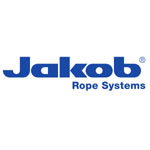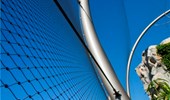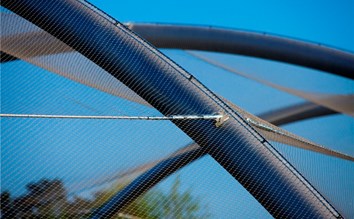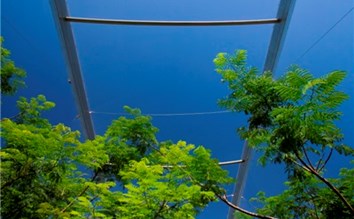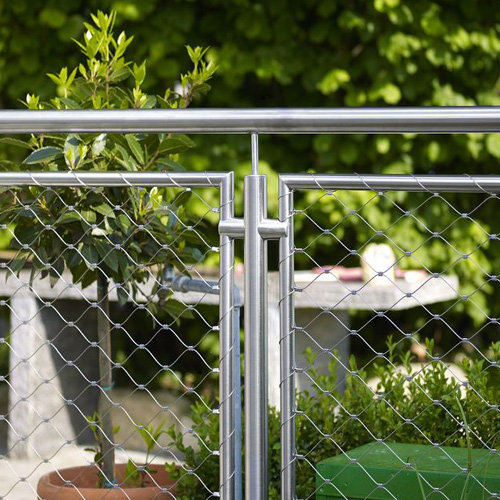Temaiken Zoo
Belén de Escobar, Buenos Aires, Argentina
Project Details
- Location
- Belén de Escobar, Buenos Aires, Argentina
- Project Year
- 2014
- Size
- 12-Meter High Supports
When the famed “Crocodile Hunter” Steve Irwin explained how he used wire mesh and other zoo enclosure materials on his famed TV program, he reminded animal fans that “we don’t want to cage them,” but protect the animals so visitors could see them in as natural state as possible.
Fast forward to 2014, and top zoos and animal sanctuaries worldwide are using new high-tech mesh designs for zoo enclosures that include bird aviaries.
In turn, the birds and other animals can enjoy their habitat without being surrounded by bars or other barriers to their human friends looking in. In fact, the great thing about today’s super strong stainless steel “Webnet” for zoo enclosures is it does not resemble a cage and is nearly invisible.
Great animal zoo viewing
Another aspect of using these new designs, such as “Webnet” for zoo enclosures, is linked to modern zoology methods that are reimagining how best to confine animals with various types of enclosures; while having the animals displayed to the public.
For instance, Webnet is credited with installing one of its famed wildlife habitat designs for the bird aviary at the Temaiken Zoo in Buenos Aires, Argentina. This breakthrough in how animals would be exhibited took place in 2010, and is still thrilling zoo fans thanks to Webnet and the Buenos Aires architectural firm Hampton & Rivoira Arquitectos.
In turn, other nature exhibits worldwide are following suit and installing Webnet enclosures for many animal species so zoo visitors can enjoy them as naturally as possible.
Stainless steel “Webnet” for enclosures
The goal for most modern creature exhibits today is to display these creatures in these super strong and high-tech designs that go far in replicating the animal’s natural habitats.
For instance, there are many nocturnal animal exhibits where animals were traditionally exhibited in buildings with glass walls with a reversed light and dark cycle to showcase the animal’s behavioral patterns.
However, the visitors could not get the real sense of being with the animals in their special climate conditions when viewing them behind glass.
To help remedy the situation, zoo officials contracted with Webnet experts to create a more natural viewing environment. For example, the mesh design not only allows visitors to see the animals better, but they can also smell the animal’s environment.
This feature is not possible when viewing animals behind the old glass wall exhibits, say officials. The result is happy visitors who can literally become more immersed in the zoo exhibit experience, thanks to this high-tech design that covers the animal’s habitat.
Viewing animals exhibits
Today’s modern animal exhibits require both special climate conditions and enclosures for insects, reptiles, mammals, birds, fish and many other types of aquatic life forms as part of walk-through exhibits.
The great thing about the trending natural enclosures “for non-aggressive species,” is better access for the visitor,” said experts commenting online. In fact, a zoologist said these new exhibits are perfect for birds, turtles, lemurs, marmosets, lizards and hundreds of other animals that visitors like to view in “as natural a state as possible.”
Moreover, many of today’s top animal exhibits worldwide have adopted mesh cage designs for their visitor immersion exhibits that are hugely popular with both the animals and the public.
The stainless steel wire mesh designs “are hardly noticeable,” said a zoo visitor commenting online about a super new bird exhibit at his local zoo that allowed children to get “even closer” to these protected life forms than ever before. The visitor even said how it “totally changed for the better how we interact with animals.”
The popular zoo exhibit web mesh designs also feature:
– A transparent “Webnet” structure that is invisible, and supported with 12-meter high steel arc supports.
– Better protection for animals.
– More natural climate conditions for exhibiting animals in their natural state.
– A feeling that the animals are not confined in traditional cages or behind bars.
– The ability to take in the complete animal exhibit experience because wire mesh allows visitors to use their sense of smell as well as getting a better visual of the animals on display.
In general, the trend in zoo design today is to keep animals in modern wire mesh enclosures without confining them with bars, fences, moats and heavy duty cages.
Creating natural animal exhibits
When the first outdoor safari park was opened by the Zoological Society of London back in 1931, the operators said they wanted visitors to come in close proximity to the animals with mesh fencing. However, it took many decades for stainless steel “Webnet” for enclosures to become the new normal for today’s top animal sanctuaries.
Overall, the result is happier visitors who say they can enjoy their favorite animals in as natural state as possible because viewing animals with this nearly invisible structure is as close to being with the animals in the wild.


